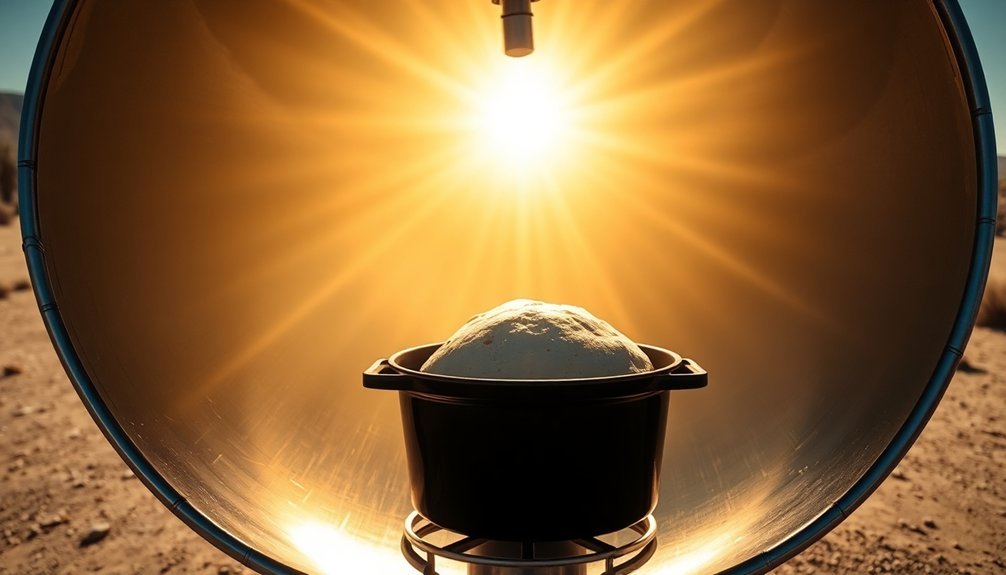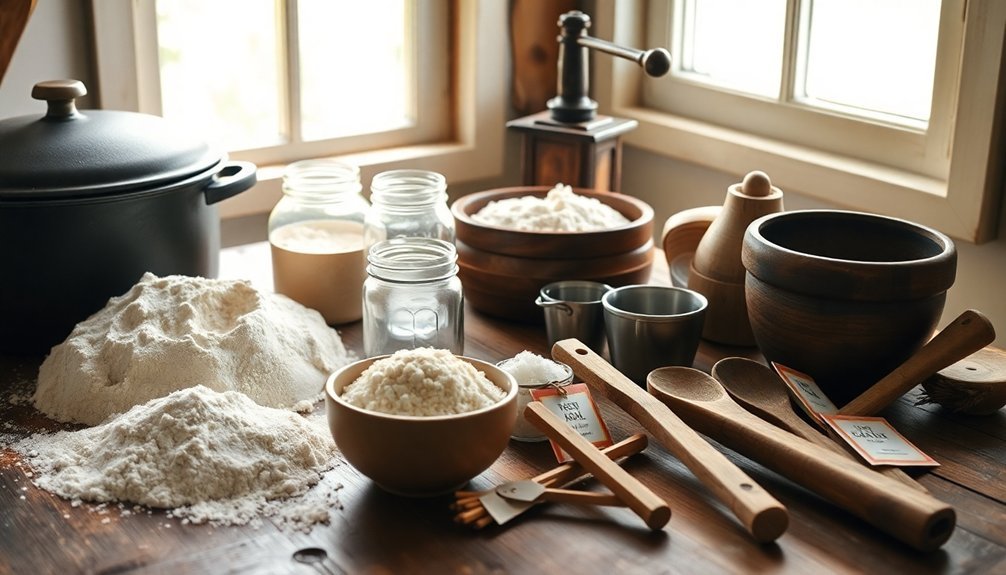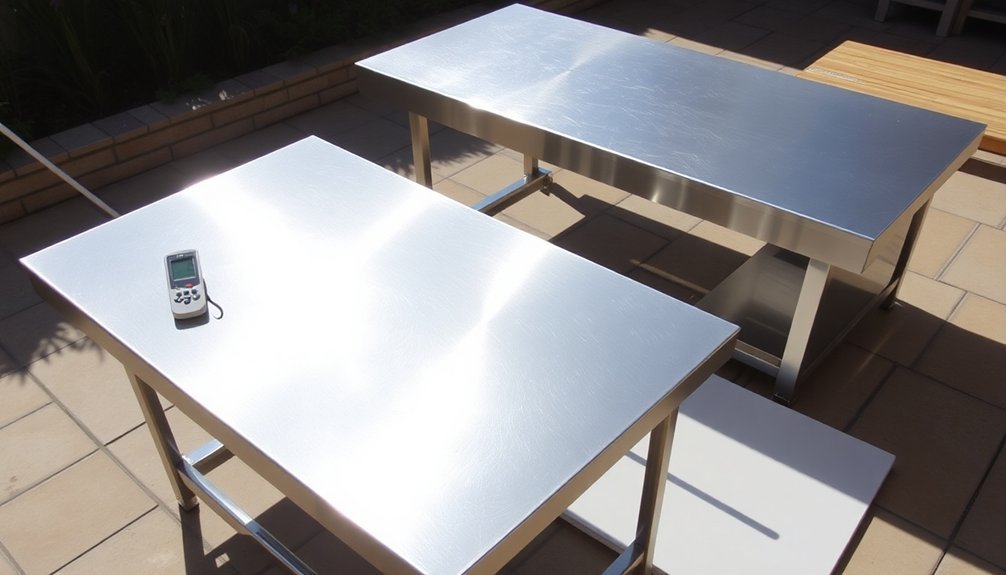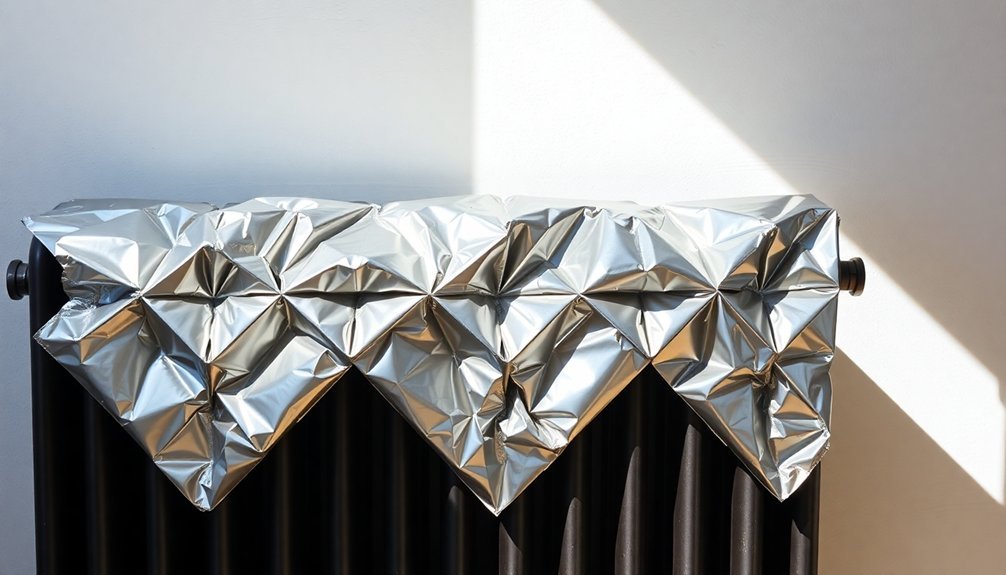You can still bake fresh bread during a power outage using five proven emergency methods. The solar parabolic oven harnesses sunlight with aluminum foil reflectors, while a traditional sun oven uses glass and reflective panels to reach up to 400°F. Your gas grill can transform into a bread-baking powerhouse by creating a two-zone heat system. For a creative solution, craft a makeshift oven from a cardboard box lined with foil and powered by charcoal. With basic ingredients like flour, leavening agents, and the right tools like a Dutch oven, you'll discover multiple ways to enjoy homemade bread off-grid.
Solar Parabolic Oven Method

A solar parabolic oven offers an effective off-grid method for baking bread using just the sun's energy.
You'll need a sturdy base made from 6mm MDF, 3mm MDF ribs, and heavy-duty aluminum foil for the reflective surface. Build the frame using 2x4s and add a pipe flange to support your cooking vessel.
The parabolic design concentrates sunlight onto a focal point where you'll place your bread pan. For organic multigrain bread, you'll need 2.5 hours of baking time. If you're making soft, round bread, aim for 180°C and bake for 20-25 minutes. Use a 24cm pan or tubes lined with parchment paper.
Before baking, preheat your solar oven. Monitor your bread by pricking with a knife to check for doneness during baking.
The tubular design creates ideal conditions for developing a beautiful crust, combining both heat and humidity.
Traditional Sun Oven Basics
Traditional sun ovens harness both direct and reflected sunlight to create an efficient baking environment. You'll get about 60% of heating energy through the glass door and 40% from the reflective panels, allowing temperatures to reach up to 400°F on clear days.
Before first use, remove the protective film from reflectors and clean the interior with soapy water after a 90-minute preheat.
To maintain ideal temperatures between 150-225°F, you'll need to reposition your oven every 30-45 minutes to track the sun. Regular cleaning of reflectors with glass cleaner will help maximize heating performance. Use dark-colored cookware with lids to maximize heat absorption, and monitor temperatures with a thermometer or Type-K thermocouple for precision.
The oven's glass, insulation, and sealing gasket work together to trap heat effectively, making it possible to bake bread even without conventional power.
Gas Grill Baking Technique

Converting your gas grill into a bread-baking oven requires precise temperature control and proper setup.
Start by preheating your grill to 450-500°F and creating a two-zone heat system by lighting the side burners while leaving the center one off.
You'll need to oil the grates and use a digital thermometer to monitor temperatures.
Place your dough on a preheated pizza stone or in a Dutch oven in the indirect heat zone. The ideal baking temperature is 375-450°F, and you'll want to maintain this consistently. Your bread will cook approximately twice as fast on the grill compared to a conventional oven.
Check your bread's progress frequently, as grilling times are shorter than conventional oven baking.
Rotate the loaf halfway through for even browning, and test for doneness when the internal temperature reaches 205-210°F.
Let your finished bread cool on a wire rack for 15 minutes before slicing.
DIY Cardboard Box Solution
When power outages strike, you can create a simple yet effective bread-baking oven using common household items.
Start with a cardboard box roughly 22" x 15" x 11" and line it completely with aluminum foil, securing it with staples and duct tape. Don't leave any cardboard exposed inside.
Create a baking rack by straightening wire hangers and positioning them across the box's width. Place an aluminum pie plate filled with charcoal at the bottom for heat. Remember to poke ventilation holes to allow proper airflow.
To use your DIY oven, secure the box flaps, leaving one short flap at 2-3 inches to form the top edge. Light the charcoal and let the oven heat up before placing your bread dough on the wire rack.
Monitor the temperature carefully to prevent burning.
Essential Ingredients and Tools

Successful bread-making during a power outage depends heavily on having the right ingredients and tools ready before you start.
You'll need basic ingredients like flour, leavening agents (baking powder or baking soda), and liquids such as milk or water. Don't forget salt and a neutral-flavored oil.
For tools, gather a cooking vessel like a cast iron pot, Dutch oven, or frying pan. You'll also need basic utensils including a mixing bowl, spatula, and cutting board. Keep baking paper and cooking spray handy.
While an oven is ideal, you can use alternative heat sources like a camp stove or campfire.
Remember to follow safety precautions when using outdoor cooking methods, and always wear oven mitts when handling hot vessels.
You can adapt your recipe based on available ingredients and tools.
Frequently Asked Questions
How Long Can I Store Emergency-Baked Bread Before It Goes Bad?
You can store your freshly baked bread for 2-5 years at room temperature in sealed containers. If you refrigerate it, it'll last 5-10 years, and freezing extends shelf life beyond 10 years.
Can I Use Expired Yeast During an Emergency Situation?
You can use expired yeast, but test it first by mixing with warm water and sugar. If it doesn't foam within 10 minutes, it's inactive. Consider storing fresh yeast properly for emergencies instead.
What's the Minimum Temperature Needed for Bread to Bake Properly?
You'll need at least 190-200°F internal bread temperature for proper baking. While most recipes use 350-425°F oven temperatures, you can bake at lower temperatures (around 284°F) if you extend the baking time.
Does Altitude Affect Baking Time When Using Alternative Cooking Methods?
Yes, altitude will affect your baking time regardless of cooking method. You'll need to increase temperatures by 15-25°F and expect longer cooking times due to lower air pressure at higher elevations.
Can I Substitute Ingredients if I Don't Have All Basics?
Yes, you can use several substitutions: baking powder for yeast, water for milk, different oils for butter, and varying flour types. Just remember flour itself is essential and can't be fully replaced.
In Summary
You've now learned five reliable ways to bake bread without electricity. Whether you're using the sun's energy with a parabolic or traditional solar oven, firing up your gas grill, or creating a makeshift cardboard box oven, you can still enjoy fresh bread during power outages. Keep these methods handy and stock up on basic ingredients – you'll never have to go without homemade bread, even in emergencies.





Leave a Reply